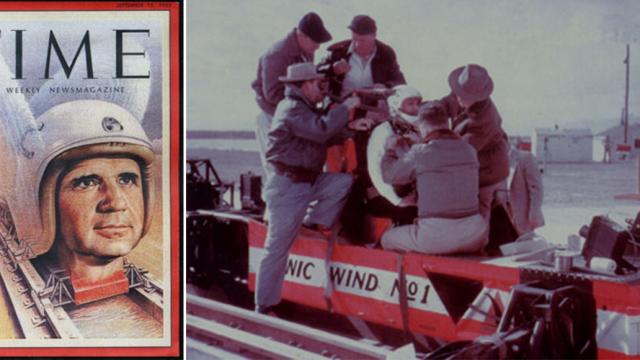In the early jet fighter days, nobody knew how much G-force the human body could withstand. Testing the limits of survivability came down to human testing. Today, we owe much of that knowledge to Col. John Paul Stapp, who strapped himself into a crazy rocket sled to see just what the human body could endure.
Col. Stapp was a physician and US Air Force flight surgeon interested in figuring out how to make jet fighter crashes and ejector seats more survivable. In 1947, Col. Stapp began a series of now-legendary rocket sled tests, personally subjecting himself to deceleration forces no human had ever before experienced, to help find the limit of what the human body could take.
That’s precisely as crazy as it sounds: Col. Stapp strapped himself into a pilot’s ejector seat mounted to a rocket sled at Muroc (now Edwards) Air Force Base. Behind him, six rockets producing 12,246kg of thrust. In front of him, 610m of track culminating in a water pool. A scoop at the front of the sled would hit the pool, instantly slamming the 678km/h rocket ride to a halt. The wild ride produced 22 G of deceleration. Col. Stapp survived.
This led to more powerful rockets, higher speeds, and even more crushing G-forces. Col. Stapp continued subjecting himself to these outrageous tests, culminating in a 1954 nine-rocket run. The 18,144kg thrust blasted Col. Stapp to 1017km/h, or Mach 0.9, in just five seconds. But as astounding as that acceleration was, the deceleration was even more enormous: At the end of the track, the sled splashed to a halt in just 1.4 seconds, subjecting Col. Stapp to more than 40 G of deceleration.
The test broke Col. Stapp’s wrists, cracked his ribs and rendered him temporarily blind from the rupture of the blood vessels in his eyes. But he survived.
The test earned Col. Stapp the honour of the highest G forces voluntarily experienced by any human. It also shut down the rocket sled program — the Air Force realised Col. Stapp’s medical and scientific research into the limits of human performance were too valuable to risk on another rocket sled run. Col. Stapp’s sled was shut down before he could achieve his greatest goal: A supersonic 1609km/h run.
Col. Stapp’s research career was far from over. After human testing on the rocket sled was halted, Col. Stapp began studying the other dangers that killed pilots. He realised that the Air Force lost nearly as many pilots to car crashes as they did to mishaps in the air; for the rest of his life, Col. Stapp pushed for greater crash safety in car design, eventually becoming permanent chairman of what would be later named the Stapp Car Crash Conference.
Despite his many wild rides on the madcap rocket sled, and the shocking forces it exerted on his body, Col. Stapp lived to be 89 years old. His legend lives on in every fighter pilot who survives an ejector seat trip, and every civilian who walks away from a forceful car crash. Many of us walk around today owing our lives to the cowboy doctor who strapped himself into a rocket sled that could very well have killed him. [Vintage Space; Amy Shira Teitel; Stapp Car Crash Conference]
Top Images: Stapp Car Crash Conference
